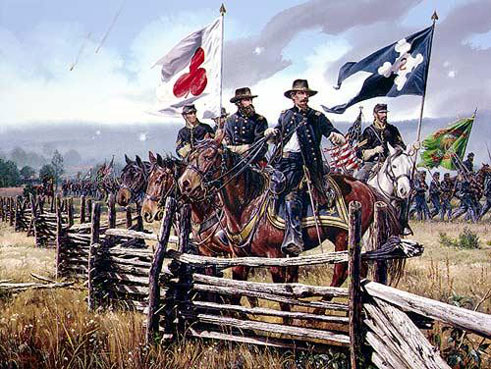44. The Battle of Gettysburg, Day 2
Located: 3rd floor, conference room inside Courtroom 4 vestibule
Print in courthouse exhibit: John Paul Strain, You Will Soon See Them Tumbling Back
Other images of interest: Don Troiani, Saving the Flag – The Wheatfield, Battle of Gettysburg, July 2, 1863; Map of Battle of Gettysburg, July 2, 1863, The Wheatfield.
The painting displayed in this exhibit captures the moment when Union commanders caught sight of the entire Third Corps marching to a position a half-mile ahead of the Union line, exposing the Union flank and ending up too far away to receive ready support. “Wait a moment,” Major General Hancock said, “You will soon see them tumbling back.” As it turned out, the Confederate attack came immediately, and the Union forces fought at the disadvantage Hancock had perceived.

Gettysburg, July 2, 1863
Major General Winfield Scott Hancock commanded the Second Corps of the Army of the Potomac at Gettysburg. On July 2, 1863, he rode between its three divisions, preparing to renew the previous day’s fight against Robert E. Lee’s Army of Northern Virginia. Anticipating a crucial Union victory, he approached New Hampshire’s esteemed Colonel Edward E. Cross of the Second Corps’ First Brigade, First Division and commented, “Colonel Cross, this day will bring you a star.” But the late afternoon engagements would turn out differently than planned.
This painting, You Will Soon See Then Tumbling Back by John Paul Strain, captures the moment when Major General Hancock and General John C. Caldwell of the First Division caught sight of General Daniel Sickles brazenly marching his entire Third Corps to a position a half-mile ahead of the Union line. General Sickles had abandoned the southern end of Cemetery Ridge and the highest defensible point in the immediate area, Little Round Top. The Third Corps’ new position exposed the Union flank and was too far away to receive ready support. “Wait a moment,” Hancock said, sensing reckless imprudence in the move against orders, “You will soon see them tumbling back.”
The Confederate attack came immediately. The Third Corps was driven back and required substantial reinforcements. Cemetery Ridge, now vulnerable to advancing Confederate troops, could be maintained only by the Union Army’s most valiant efforts in Devil’s Den, the Peach Orchard and the Wheatfield. General Sickles later stated that “men fought there, hand to hand, I think, as never they grappled before. Onward and over against each other they bent again and again.” The Second Corps incurred very heavy losses, including a marksman’s killing of Colonel Cross.
Ultimately, Little Round Top’s defense was ensured by the Fifth Corps’ Twentieth Maine Regiment, led by Colonel Joshua Chamberlain. Nearly out of ammunition, the Twentieth Maine Volunteers received Chamberlain’s order to “Fix bayonets!” and charged downhill, surprising the enemy with an overwhelming assault. The fight continued on July 3, when Pickett’s Charge, the Confederates’ final failed attack on Cemetery Ridge, would decide the Battle of Gettysburg in favor of the Union.








